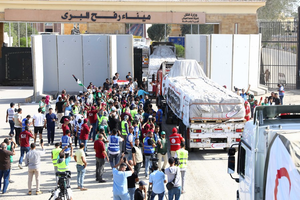UN says delivering aid to Gaza remains challenging
By IANS | Updated: October 23, 2025 04:40 IST2025-10-23T04:37:07+5:302025-10-23T04:40:15+5:30
United Nations, Oct 23 UN humanitarians have said that delivering vital support to northern Gaza remains challenging, even ...

UN says delivering aid to Gaza remains challenging
United Nations, Oct 23 UN humanitarians have said that delivering vital support to northern Gaza remains challenging, even though the ceasefire took effect more than 10 days ago.
The UN Office for the Coordination of Humanitarian Affairs (OCHA) said on Wednesday that since the ceasefire took effect on October 10, the world body and its partners have made progress in scaling up response efforts, especially in central and southern areas of the Gaza Strip.
However, the continued closure of the Zikim and Erez border crossings, which provide direct access to the north, makes it extremely challenging for humanitarian aid to reach the area, OCHA added.
At the same time, UN partners monitoring population flows across Gaza have reported more than 425,000 movements from southern to northern parts of the strip since October 10, Xinhua news agency reported.
UN Population Fund Deputy Executive Director Andrew Saberton, who just returned from Gaza, told reporters that the agency was able to bring in some assistance last week through the Kerem Shalom/Karem Abu Salem crossing.
"We have been distributing medical supplies and equipment, including incubators, delivery beds and fetal monitoring machines, that were prepositioned inside Gaza, to hospitals," he said.
"But the trickle of aid being allowed to enter Gaza after the ceasefire is nowhere near enough."
Inside Gaza on Tuesday, out of 10 humanitarian missions coordinated with the Israeli authorities, six were facilitated, including the collection of water tanks, hygiene kits and fuel from the crossings into Gaza, OCHA said.
Abeer Etefa, senior regional communications officer and spokesperson for the World Food Programme (WFP), said that since the ceasefire began on October 11, the agency has delivered more than 6,700 metric tonnes of food, enough for nearly half a million people for two weeks.
"Daily deliveries continue and now average around 750 tonnes," she said, noting this remains well below WFP's target of 2,000 tonnes a day.
"Unless all border crossing points are used, reaching this target is almost impossible."
Currently, only the Kerem Shalom and Kissufim crossings in the south are open. Severe destruction continues to block access to northern Gaza, where famine was declared in August. "We need Erez, we need Zikkim, we need these border crossing points to open," Etefa stressed.
Reaching northern Gaza with large-scale convoys is a priority.
"We've cleared roads at scale into the north," she said, "but we need these crossings open to connect to Gaza City, where conditions are especially dire."
WFP is restoring its food distribution network, aiming for 145 distribution points across the Strip, of which 26 have reopened. "People are showing up in large numbers, grateful for the efficiency and the dignified way they can collect their rations," Etefa said.
The aid is especially crucial for "the most vulnerable," the women, female-headed households, and the elderly, she added.
While many are hopeful, "there is cautious optimism" about how long current conditions will last.
Many families save part of their rations because they are not confident the ceasefire will hold.
"It is a fragile peace," she said.
Food prices remain prohibitive, and supplies are still insufficient. "People can find food in the market, but it's out of reach because it's extremely expensive," Etefa warned.
WFP is also helping the most food-insecure households through digital payments, enabling about 140,000 people to buy food locally, with plans to double that number soon. But Etefa stressed that humanitarian aid alone cannot solve the crisis, and commercial supplies must enter to complement relief efforts.
Only a fully implemented and sustained ceasefire can allow WFP to operate at the scale needed, Etefa said.
Disclaimer: This post has been auto-published from an agency feed without any modifications to the text and has not been reviewed by an editor
Open in app